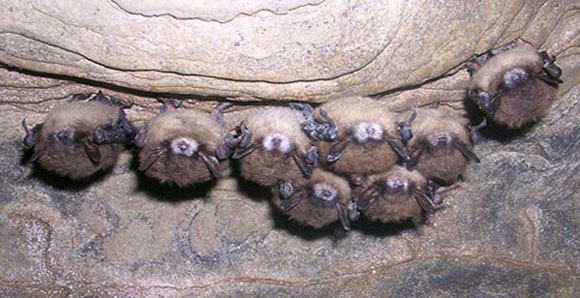White-nose syndrome (WNS) is a fungal disease killing hibernating bats in North America. The fungus, named Pseudogymnoascus destructans (or Pd for short) likely originated in Europe or Asia. Sometime in the early 2000's Pd arrived in North America and attacked vulnerable bat species, resulting in unusual and large die-offs of bats first observed in New York in 2006. Since then, the disease has spread to most US states and Canadian provinces, leaving millions of dead bats in its path. WNS causes high death rates and fast population declines in the species affected by it. Three species, little brown bats, northern long-eared bats and tri-colored bats, declined by more than 90% across the eastern US by 2018. The declines have been so fast and severe, the northern long-eared bat (Myotis spetentronalis) has been listed as endangered and the tricolored bat (Perimyotis subflavus) has been proposed for listing under the Endangered Species Act.
How does WNS Kills Bats?

NYSDEC/Nancy Heaslip
The disease is called “white-nose syndrome” (WNS) because of the visible white fungal growth on infected bats’ muzzles and wings. However, the real damage occurs in the wings, which are essential for flight, and other vital physiologic processes like heat exchange, circulation, and water balance. This cold-loving fungus infects bats during hibernation, when the bats reduce their metabolic rate and lower their body temperature to save energy over winter. Hibernating bats affected by WNS wake up to warm temperatures more frequently, which results in using up fat reserves and often starve to death before spring arrives.
The visible signs of WNS show the disease is in a later stage. These bats are already dealing with life-threatening physical function changes, such as electrolyte imbalances and dehydration. Even before the infected bats start to wake more often, infection with the fungus causes bats to use energy twice as fast as healthy bats.
In addition to the white muzzles and wings, bats acting strangely could indicate WNS. This includes bats flying outside during the day in freezing temperatures during winter. Another sign is bats clustering around entrances of hibernacula (places where they hibernate) or dead or dying bats on the ground in winter.
If you see a sick or dead bat, don’t touch it and tell a park ranger.
How does WNS spread?
The fungus that causes WNS is primarily spread by bats, but humans can contribute to its spread too. Bats can catch the fungus from physical contact with infected bats. Also, bats can pick up the fungus from the environments where they roost, especially roosts used for hibernation (like caves and mines, but also rock crevices or other structures). Humans can spread the fungus from one hibernaculum to another by accidentally carrying the fungus on shoes, clothing, or gear. So, it's really important to not bring clothing or gear into a WNS-free site that was previously used in a WNS-affected site. You can help slow the spread of WNS by cleaning and decontaminating your gear and shoes before entering caves or other areas where bats hibernate. Learn how to decontaminate your caving gear.
How does WNS Affect Human Health?
Current evidence indicates that the fungus doesn't infect humans. Studies have shown that the fungus grows only at cold temperatures (41-68 degrees F) that are much lower than that of the human body. Also, no human infections have ever been documented after exposure to WNS-infected bats or caves.
Although WNS does not cause illness in humans, a small percentage of bats can be infected with other dangerous diseases, such as rabies. Bats infected with either WNS or rabies may exhibit unusual behavior (e.g. erratic flying), which increases the risk for bat-human contact and exposure. Additionally, declines in bat populations can impact human health indirectly since humans depend on bats for important ecosystem services such as controlling pest insects. A recent study found that in countries where bats were affected by WNS, insecticide use on crops increased by about 30%, which was associated with a nearly 8% increase in infant mortality rates.
What is the National Park Service doing to fight WNS?
Many things! Park staff are busy monitoring bats, educating visitors about WNS, and protecting bat habitats. Our scientists work with researchers from other agencies and universities to learn more about WNS, its effects on bats and what we can do to help improve their survival. Some parks close certain caves to protect hibernacula and maternity roosts during times when bats are most vulnerable to disturbance. Specific actions also vary from park to park, so be sure to read and follow instructions during your visit to help protect the bats who live there. Some parks may offer to clean your shoes, while others may require you to leave any clothing or items that have previously been underground behind before entering a cave in the park. If WNS occurs in the park, you may be required to walk across decontamination mats when exiting a cave to help prevent spreading the fungus to other areas.
What can I do to help bats affected by WNS?
Bat are cool animals and provide many benefits to our ecosystems, our economy and our own well-being. Just like us they rely on quality food, shelter and healthy ecosystems to thrive. Learn about all the actions you can take to help bats while in parks and at home.
For more information on WNS, check out whitenosesyndrome.org.
Last updated: December 8, 2017
